Statistical Analysis: Power and Sample Size Determination in Research
VerifiedAdded on 2022/11/28
|9
|1681
|362
Report
AI Summary
This report provides a comprehensive analysis of power and sample size determination in research, emphasizing their critical role in achieving statistically accurate and reliable study results. It explains the concepts of power and sample size, highlighting their impact on error margins, variability, and bias. The report delves into the importance of selecting an appropriate sample size to ensure accurate statistical assessments and the implications of insufficient sample sizes. It discusses the inverse relationship between sample size and the margin of error, along with the reduction of variability with increased sample sizes. Furthermore, the report explores real-world examples, including studies on liraglutide for cardiovascular outcomes, non-alcoholic fatty liver disease, and the association between blood mercury levels and type 2 diabetes. These examples illustrate how proper sample size and power analysis lead to statistically significant findings and desired confidence intervals, reinforcing the significance of these methodological considerations in research design and data analysis. The report concludes with the understanding that appropriate power and sample size determination are essential for ensuring the validity and reliability of research findings.
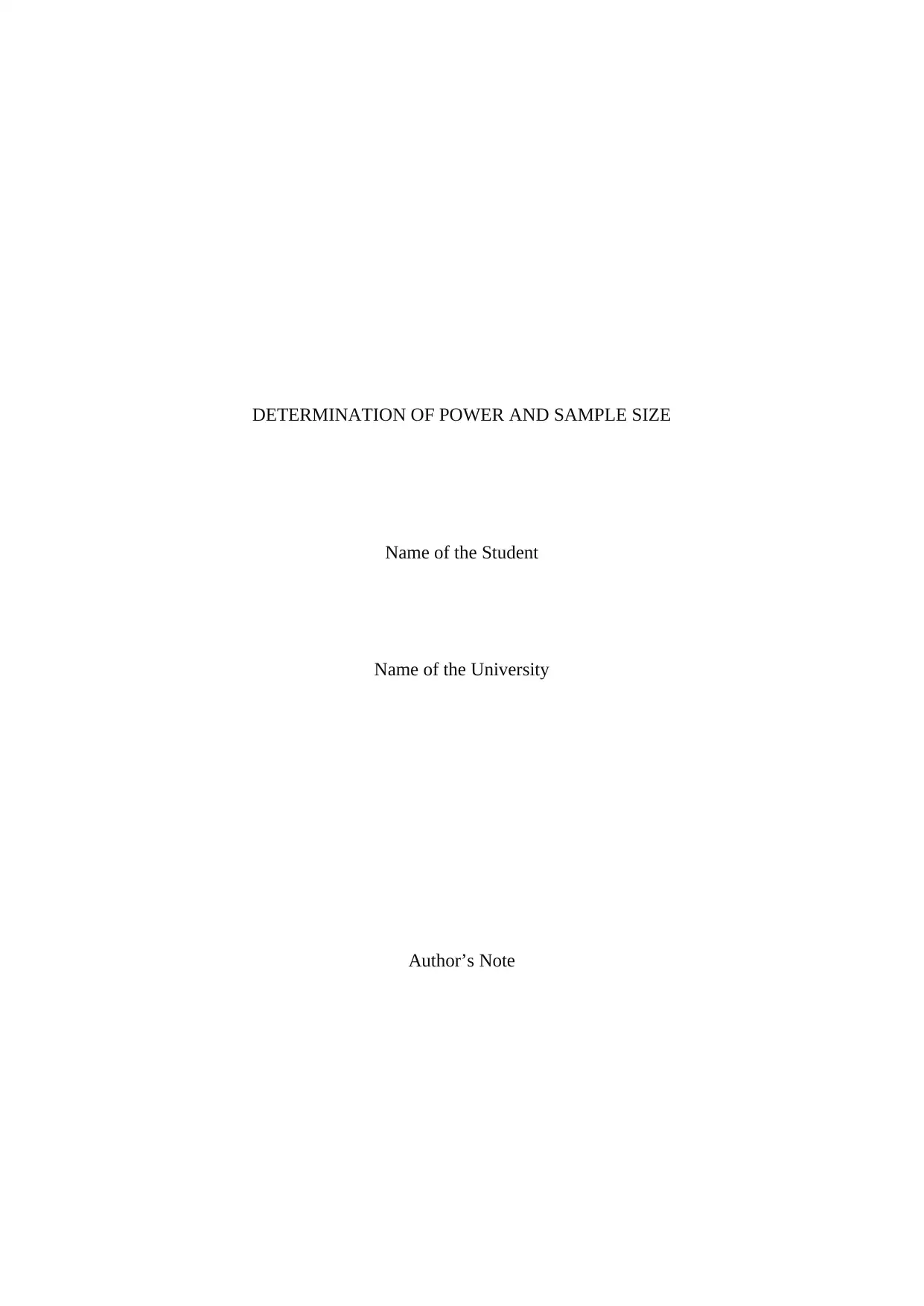
DETERMINATION OF POWER AND SAMPLE SIZE
Name of the Student
Name of the University
Author’s Note
Name of the Student
Name of the University
Author’s Note
Paraphrase This Document
Need a fresh take? Get an instant paraphrase of this document with our AI Paraphraser
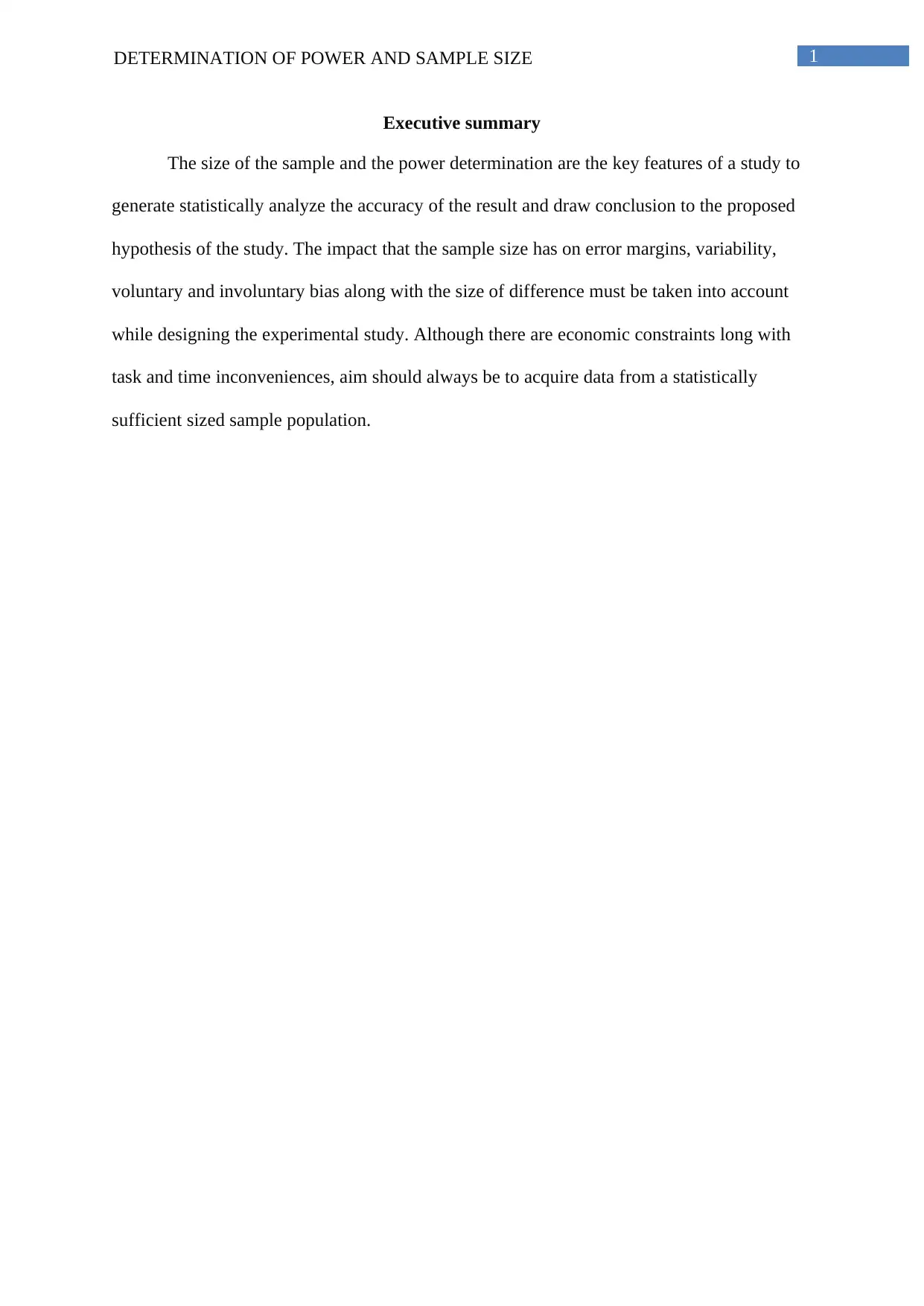
1DETERMINATION OF POWER AND SAMPLE SIZE
Executive summary
The size of the sample and the power determination are the key features of a study to
generate statistically analyze the accuracy of the result and draw conclusion to the proposed
hypothesis of the study. The impact that the sample size has on error margins, variability,
voluntary and involuntary bias along with the size of difference must be taken into account
while designing the experimental study. Although there are economic constraints long with
task and time inconveniences, aim should always be to acquire data from a statistically
sufficient sized sample population.
Executive summary
The size of the sample and the power determination are the key features of a study to
generate statistically analyze the accuracy of the result and draw conclusion to the proposed
hypothesis of the study. The impact that the sample size has on error margins, variability,
voluntary and involuntary bias along with the size of difference must be taken into account
while designing the experimental study. Although there are economic constraints long with
task and time inconveniences, aim should always be to acquire data from a statistically
sufficient sized sample population.
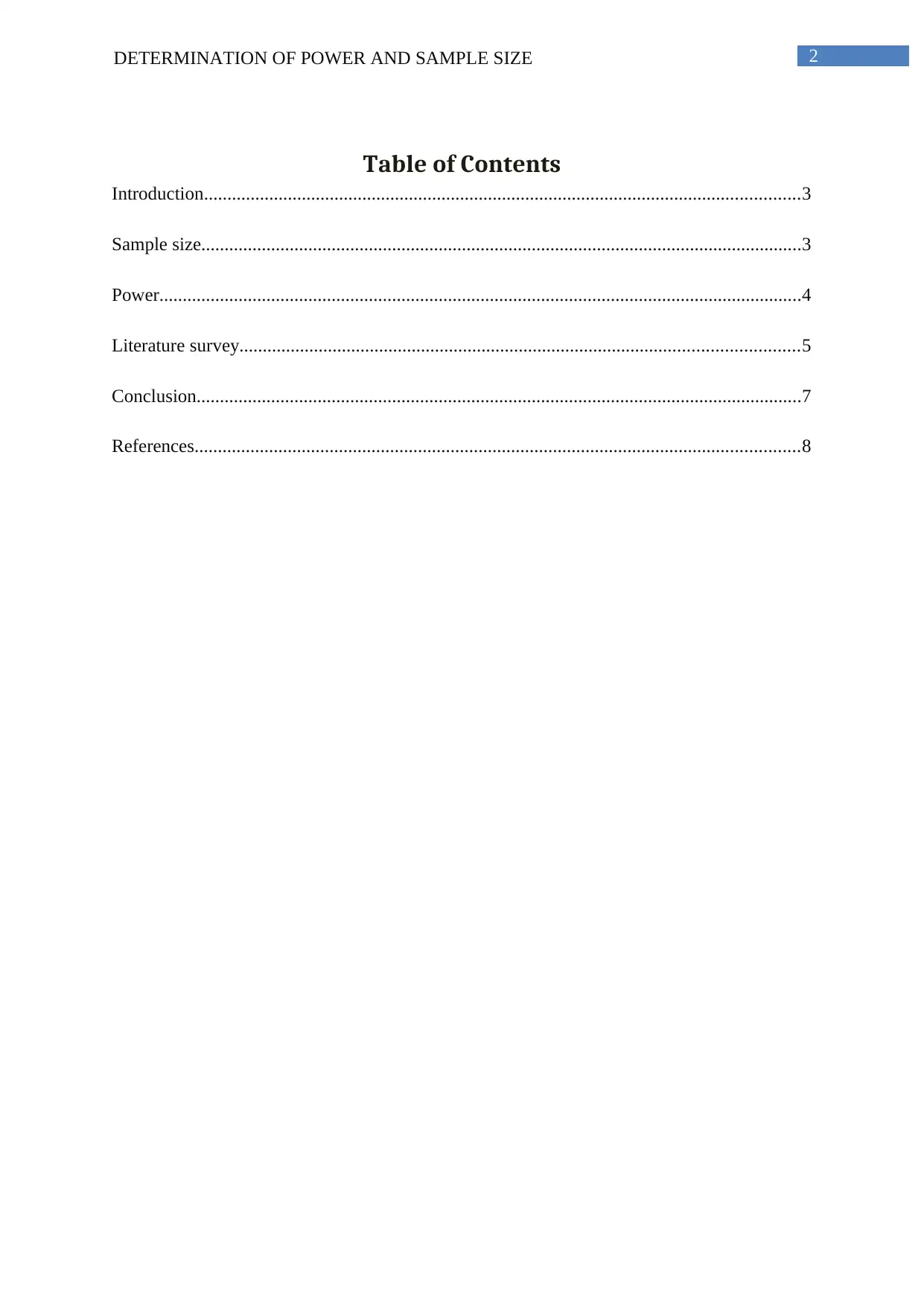
2DETERMINATION OF POWER AND SAMPLE SIZE
Table of Contents
Introduction................................................................................................................................3
Sample size.................................................................................................................................3
Power..........................................................................................................................................4
Literature survey........................................................................................................................5
Conclusion..................................................................................................................................7
References..................................................................................................................................8
Table of Contents
Introduction................................................................................................................................3
Sample size.................................................................................................................................3
Power..........................................................................................................................................4
Literature survey........................................................................................................................5
Conclusion..................................................................................................................................7
References..................................................................................................................................8
⊘ This is a preview!⊘
Do you want full access?
Subscribe today to unlock all pages.

Trusted by 1+ million students worldwide
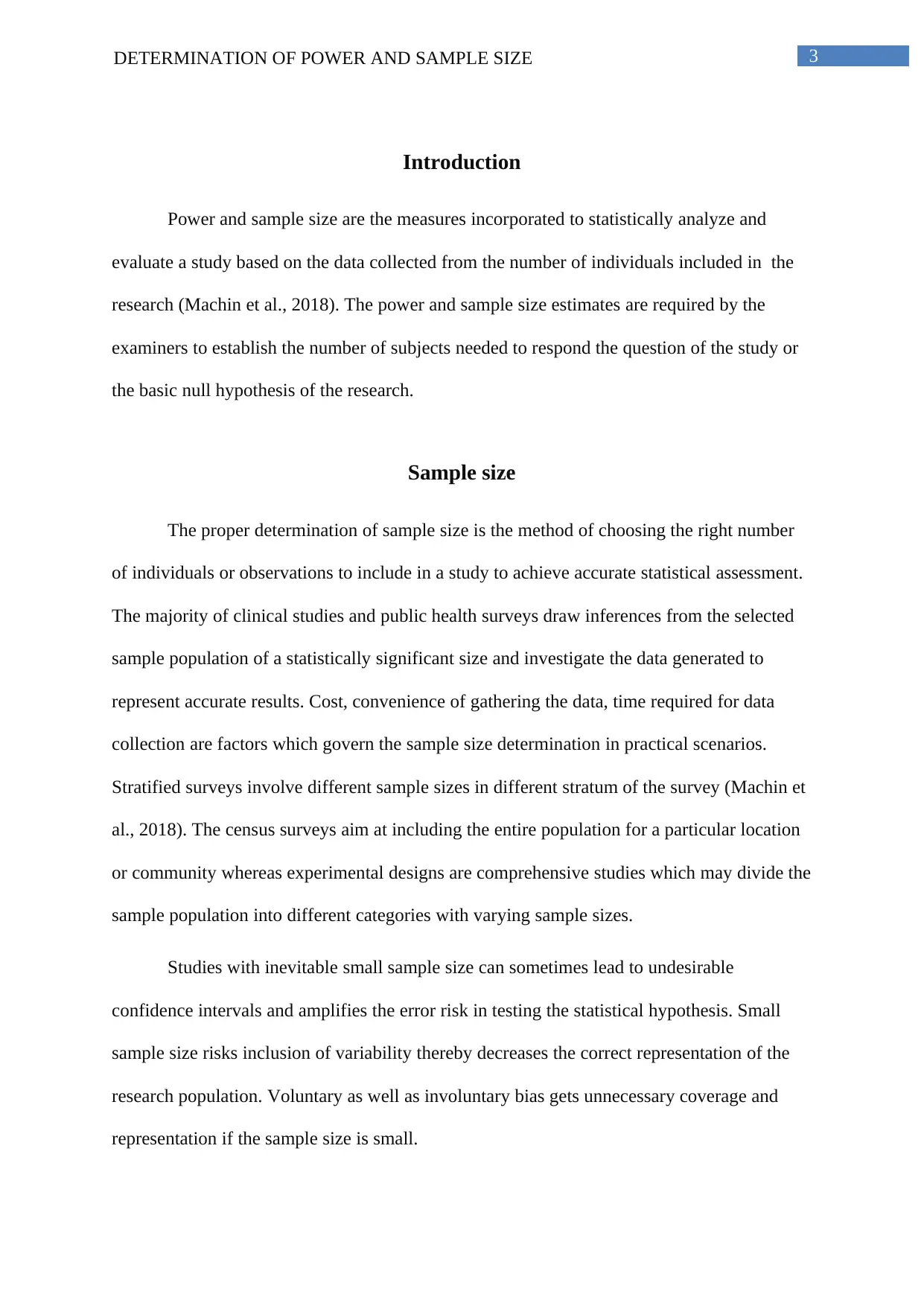
3DETERMINATION OF POWER AND SAMPLE SIZE
Introduction
Power and sample size are the measures incorporated to statistically analyze and
evaluate a study based on the data collected from the number of individuals included in the
research (Machin et al., 2018). The power and sample size estimates are required by the
examiners to establish the number of subjects needed to respond the question of the study or
the basic null hypothesis of the research.
Sample size
The proper determination of sample size is the method of choosing the right number
of individuals or observations to include in a study to achieve accurate statistical assessment.
The majority of clinical studies and public health surveys draw inferences from the selected
sample population of a statistically significant size and investigate the data generated to
represent accurate results. Cost, convenience of gathering the data, time required for data
collection are factors which govern the sample size determination in practical scenarios.
Stratified surveys involve different sample sizes in different stratum of the survey (Machin et
al., 2018). The census surveys aim at including the entire population for a particular location
or community whereas experimental designs are comprehensive studies which may divide the
sample population into different categories with varying sample sizes.
Studies with inevitable small sample size can sometimes lead to undesirable
confidence intervals and amplifies the error risk in testing the statistical hypothesis. Small
sample size risks inclusion of variability thereby decreases the correct representation of the
research population. Voluntary as well as involuntary bias gets unnecessary coverage and
representation if the sample size is small.
Introduction
Power and sample size are the measures incorporated to statistically analyze and
evaluate a study based on the data collected from the number of individuals included in the
research (Machin et al., 2018). The power and sample size estimates are required by the
examiners to establish the number of subjects needed to respond the question of the study or
the basic null hypothesis of the research.
Sample size
The proper determination of sample size is the method of choosing the right number
of individuals or observations to include in a study to achieve accurate statistical assessment.
The majority of clinical studies and public health surveys draw inferences from the selected
sample population of a statistically significant size and investigate the data generated to
represent accurate results. Cost, convenience of gathering the data, time required for data
collection are factors which govern the sample size determination in practical scenarios.
Stratified surveys involve different sample sizes in different stratum of the survey (Machin et
al., 2018). The census surveys aim at including the entire population for a particular location
or community whereas experimental designs are comprehensive studies which may divide the
sample population into different categories with varying sample sizes.
Studies with inevitable small sample size can sometimes lead to undesirable
confidence intervals and amplifies the error risk in testing the statistical hypothesis. Small
sample size risks inclusion of variability thereby decreases the correct representation of the
research population. Voluntary as well as involuntary bias gets unnecessary coverage and
representation if the sample size is small.
Paraphrase This Document
Need a fresh take? Get an instant paraphrase of this document with our AI Paraphraser
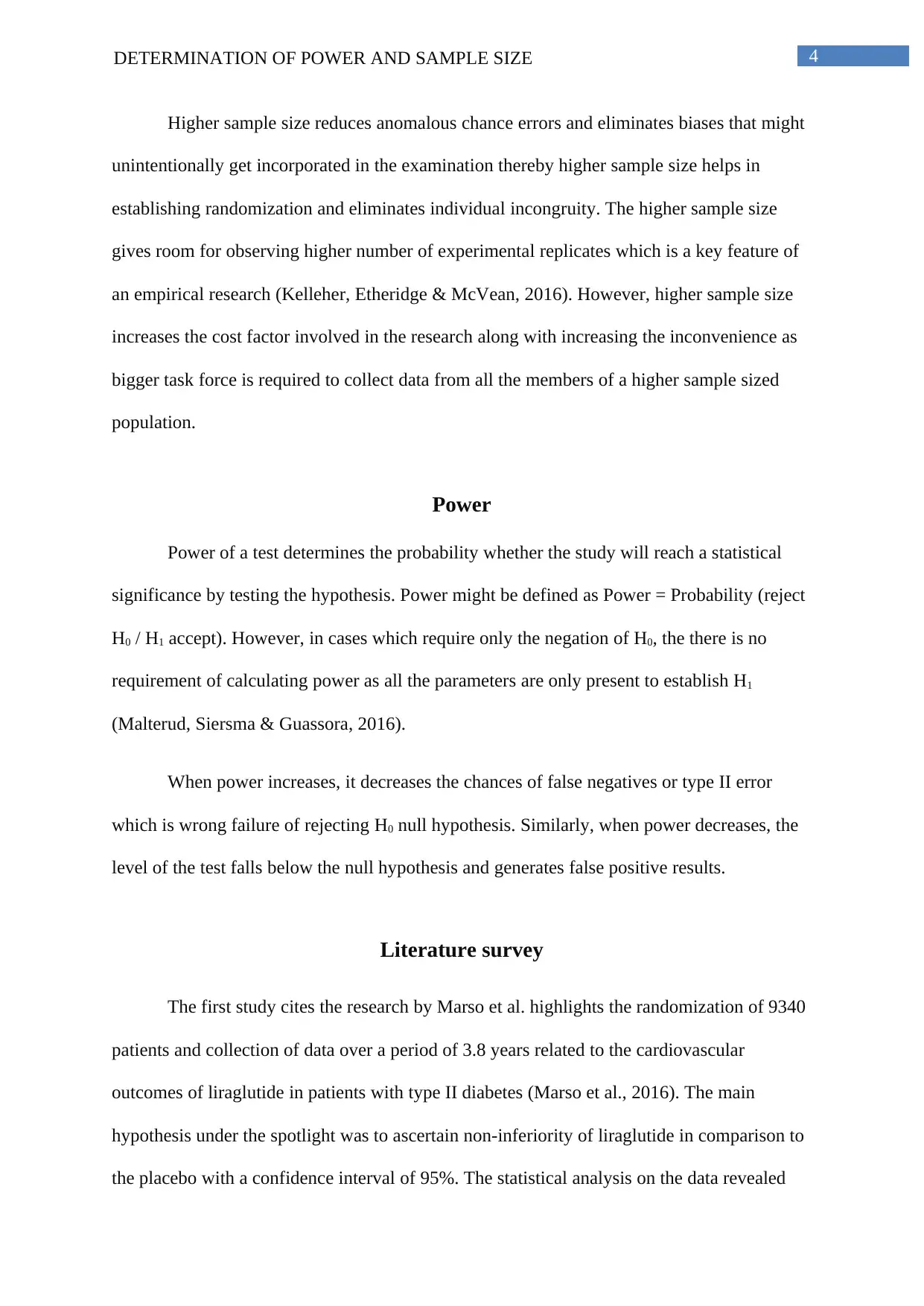
4DETERMINATION OF POWER AND SAMPLE SIZE
Higher sample size reduces anomalous chance errors and eliminates biases that might
unintentionally get incorporated in the examination thereby higher sample size helps in
establishing randomization and eliminates individual incongruity. The higher sample size
gives room for observing higher number of experimental replicates which is a key feature of
an empirical research (Kelleher, Etheridge & McVean, 2016). However, higher sample size
increases the cost factor involved in the research along with increasing the inconvenience as
bigger task force is required to collect data from all the members of a higher sample sized
population.
Power
Power of a test determines the probability whether the study will reach a statistical
significance by testing the hypothesis. Power might be defined as Power = Probability (reject
H0 / H1 accept). However, in cases which require only the negation of H0, the there is no
requirement of calculating power as all the parameters are only present to establish H1
(Malterud, Siersma & Guassora, 2016).
When power increases, it decreases the chances of false negatives or type II error
which is wrong failure of rejecting H0 null hypothesis. Similarly, when power decreases, the
level of the test falls below the null hypothesis and generates false positive results.
Literature survey
The first study cites the research by Marso et al. highlights the randomization of 9340
patients and collection of data over a period of 3.8 years related to the cardiovascular
outcomes of liraglutide in patients with type II diabetes (Marso et al., 2016). The main
hypothesis under the spotlight was to ascertain non-inferiority of liraglutide in comparison to
the placebo with a confidence interval of 95%. The statistical analysis on the data revealed
Higher sample size reduces anomalous chance errors and eliminates biases that might
unintentionally get incorporated in the examination thereby higher sample size helps in
establishing randomization and eliminates individual incongruity. The higher sample size
gives room for observing higher number of experimental replicates which is a key feature of
an empirical research (Kelleher, Etheridge & McVean, 2016). However, higher sample size
increases the cost factor involved in the research along with increasing the inconvenience as
bigger task force is required to collect data from all the members of a higher sample sized
population.
Power
Power of a test determines the probability whether the study will reach a statistical
significance by testing the hypothesis. Power might be defined as Power = Probability (reject
H0 / H1 accept). However, in cases which require only the negation of H0, the there is no
requirement of calculating power as all the parameters are only present to establish H1
(Malterud, Siersma & Guassora, 2016).
When power increases, it decreases the chances of false negatives or type II error
which is wrong failure of rejecting H0 null hypothesis. Similarly, when power decreases, the
level of the test falls below the null hypothesis and generates false positive results.
Literature survey
The first study cites the research by Marso et al. highlights the randomization of 9340
patients and collection of data over a period of 3.8 years related to the cardiovascular
outcomes of liraglutide in patients with type II diabetes (Marso et al., 2016). The main
hypothesis under the spotlight was to ascertain non-inferiority of liraglutide in comparison to
the placebo with a confidence interval of 95%. The statistical analysis on the data revealed
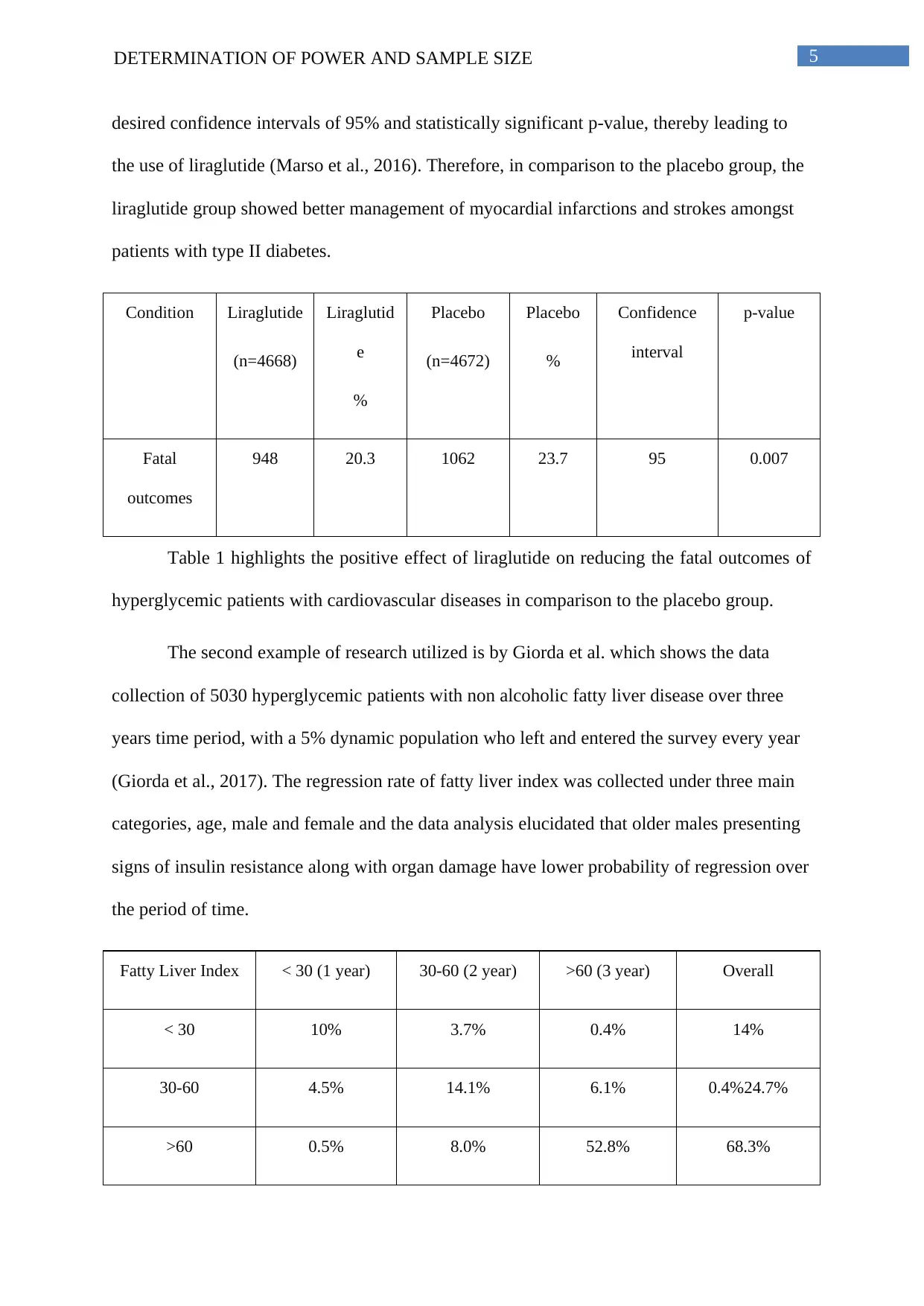
5DETERMINATION OF POWER AND SAMPLE SIZE
desired confidence intervals of 95% and statistically significant p-value, thereby leading to
the use of liraglutide (Marso et al., 2016). Therefore, in comparison to the placebo group, the
liraglutide group showed better management of myocardial infarctions and strokes amongst
patients with type II diabetes.
Condition Liraglutide
(n=4668)
Liraglutid
e
%
Placebo
(n=4672)
Placebo
%
Confidence
interval
p-value
Fatal
outcomes
948 20.3 1062 23.7 95 0.007
Table 1 highlights the positive effect of liraglutide on reducing the fatal outcomes of
hyperglycemic patients with cardiovascular diseases in comparison to the placebo group.
The second example of research utilized is by Giorda et al. which shows the data
collection of 5030 hyperglycemic patients with non alcoholic fatty liver disease over three
years time period, with a 5% dynamic population who left and entered the survey every year
(Giorda et al., 2017). The regression rate of fatty liver index was collected under three main
categories, age, male and female and the data analysis elucidated that older males presenting
signs of insulin resistance along with organ damage have lower probability of regression over
the period of time.
Fatty Liver Index < 30 (1 year) 30-60 (2 year) >60 (3 year) Overall
< 30 10% 3.7% 0.4% 14%
30-60 4.5% 14.1% 6.1% 0.4%24.7%
>60 0.5% 8.0% 52.8% 68.3%
desired confidence intervals of 95% and statistically significant p-value, thereby leading to
the use of liraglutide (Marso et al., 2016). Therefore, in comparison to the placebo group, the
liraglutide group showed better management of myocardial infarctions and strokes amongst
patients with type II diabetes.
Condition Liraglutide
(n=4668)
Liraglutid
e
%
Placebo
(n=4672)
Placebo
%
Confidence
interval
p-value
Fatal
outcomes
948 20.3 1062 23.7 95 0.007
Table 1 highlights the positive effect of liraglutide on reducing the fatal outcomes of
hyperglycemic patients with cardiovascular diseases in comparison to the placebo group.
The second example of research utilized is by Giorda et al. which shows the data
collection of 5030 hyperglycemic patients with non alcoholic fatty liver disease over three
years time period, with a 5% dynamic population who left and entered the survey every year
(Giorda et al., 2017). The regression rate of fatty liver index was collected under three main
categories, age, male and female and the data analysis elucidated that older males presenting
signs of insulin resistance along with organ damage have lower probability of regression over
the period of time.
Fatty Liver Index < 30 (1 year) 30-60 (2 year) >60 (3 year) Overall
< 30 10% 3.7% 0.4% 14%
30-60 4.5% 14.1% 6.1% 0.4%24.7%
>60 0.5% 8.0% 52.8% 68.3%
⊘ This is a preview!⊘
Do you want full access?
Subscribe today to unlock all pages.

Trusted by 1+ million students worldwide
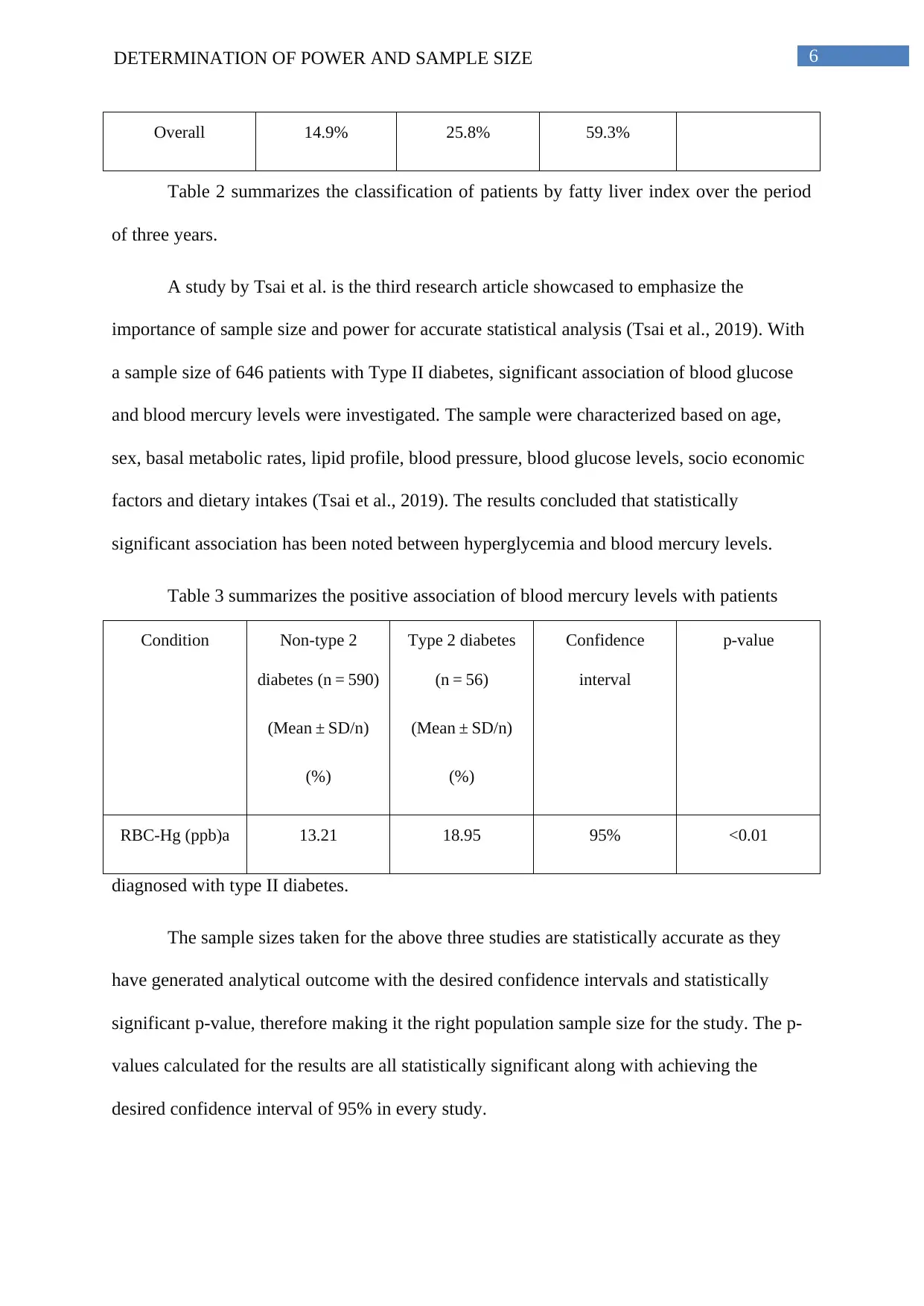
6DETERMINATION OF POWER AND SAMPLE SIZE
Overall 14.9% 25.8% 59.3%
Table 2 summarizes the classification of patients by fatty liver index over the period
of three years.
A study by Tsai et al. is the third research article showcased to emphasize the
importance of sample size and power for accurate statistical analysis (Tsai et al., 2019). With
a sample size of 646 patients with Type II diabetes, significant association of blood glucose
and blood mercury levels were investigated. The sample were characterized based on age,
sex, basal metabolic rates, lipid profile, blood pressure, blood glucose levels, socio economic
factors and dietary intakes (Tsai et al., 2019). The results concluded that statistically
significant association has been noted between hyperglycemia and blood mercury levels.
Table 3 summarizes the positive association of blood mercury levels with patients
diagnosed with type II diabetes.
The sample sizes taken for the above three studies are statistically accurate as they
have generated analytical outcome with the desired confidence intervals and statistically
significant p-value, therefore making it the right population sample size for the study. The p-
values calculated for the results are all statistically significant along with achieving the
desired confidence interval of 95% in every study.
Condition Non-type 2
diabetes (n = 590)
(Mean ± SD/n)
(%)
Type 2 diabetes
(n = 56)
(Mean ± SD/n)
(%)
Confidence
interval
p-value
RBC-Hg (ppb)a 13.21 18.95 95% <0.01
Overall 14.9% 25.8% 59.3%
Table 2 summarizes the classification of patients by fatty liver index over the period
of three years.
A study by Tsai et al. is the third research article showcased to emphasize the
importance of sample size and power for accurate statistical analysis (Tsai et al., 2019). With
a sample size of 646 patients with Type II diabetes, significant association of blood glucose
and blood mercury levels were investigated. The sample were characterized based on age,
sex, basal metabolic rates, lipid profile, blood pressure, blood glucose levels, socio economic
factors and dietary intakes (Tsai et al., 2019). The results concluded that statistically
significant association has been noted between hyperglycemia and blood mercury levels.
Table 3 summarizes the positive association of blood mercury levels with patients
diagnosed with type II diabetes.
The sample sizes taken for the above three studies are statistically accurate as they
have generated analytical outcome with the desired confidence intervals and statistically
significant p-value, therefore making it the right population sample size for the study. The p-
values calculated for the results are all statistically significant along with achieving the
desired confidence interval of 95% in every study.
Condition Non-type 2
diabetes (n = 590)
(Mean ± SD/n)
(%)
Type 2 diabetes
(n = 56)
(Mean ± SD/n)
(%)
Confidence
interval
p-value
RBC-Hg (ppb)a 13.21 18.95 95% <0.01
Paraphrase This Document
Need a fresh take? Get an instant paraphrase of this document with our AI Paraphraser
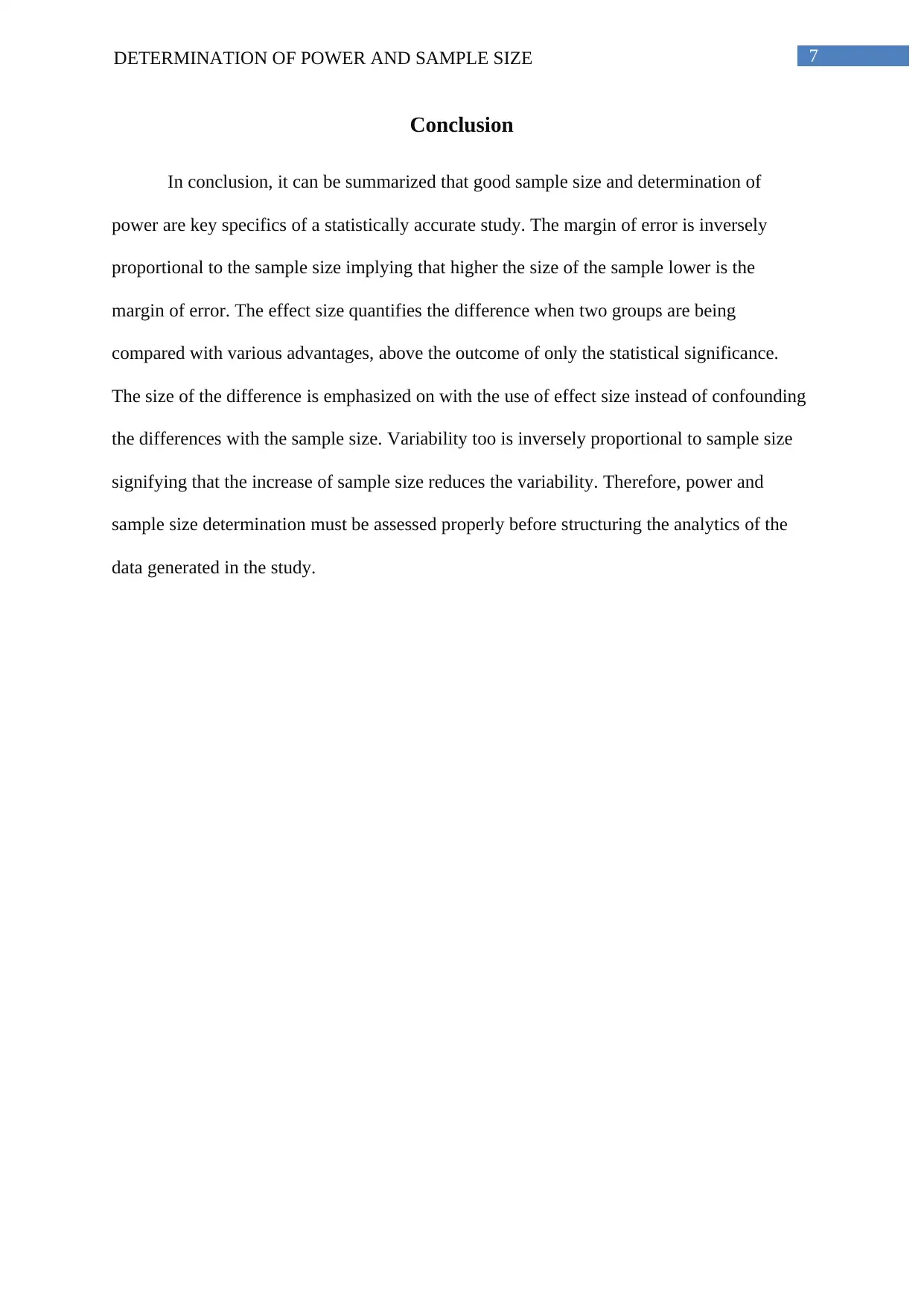
7DETERMINATION OF POWER AND SAMPLE SIZE
Conclusion
In conclusion, it can be summarized that good sample size and determination of
power are key specifics of a statistically accurate study. The margin of error is inversely
proportional to the sample size implying that higher the size of the sample lower is the
margin of error. The effect size quantifies the difference when two groups are being
compared with various advantages, above the outcome of only the statistical significance.
The size of the difference is emphasized on with the use of effect size instead of confounding
the differences with the sample size. Variability too is inversely proportional to sample size
signifying that the increase of sample size reduces the variability. Therefore, power and
sample size determination must be assessed properly before structuring the analytics of the
data generated in the study.
Conclusion
In conclusion, it can be summarized that good sample size and determination of
power are key specifics of a statistically accurate study. The margin of error is inversely
proportional to the sample size implying that higher the size of the sample lower is the
margin of error. The effect size quantifies the difference when two groups are being
compared with various advantages, above the outcome of only the statistical significance.
The size of the difference is emphasized on with the use of effect size instead of confounding
the differences with the sample size. Variability too is inversely proportional to sample size
signifying that the increase of sample size reduces the variability. Therefore, power and
sample size determination must be assessed properly before structuring the analytics of the
data generated in the study.
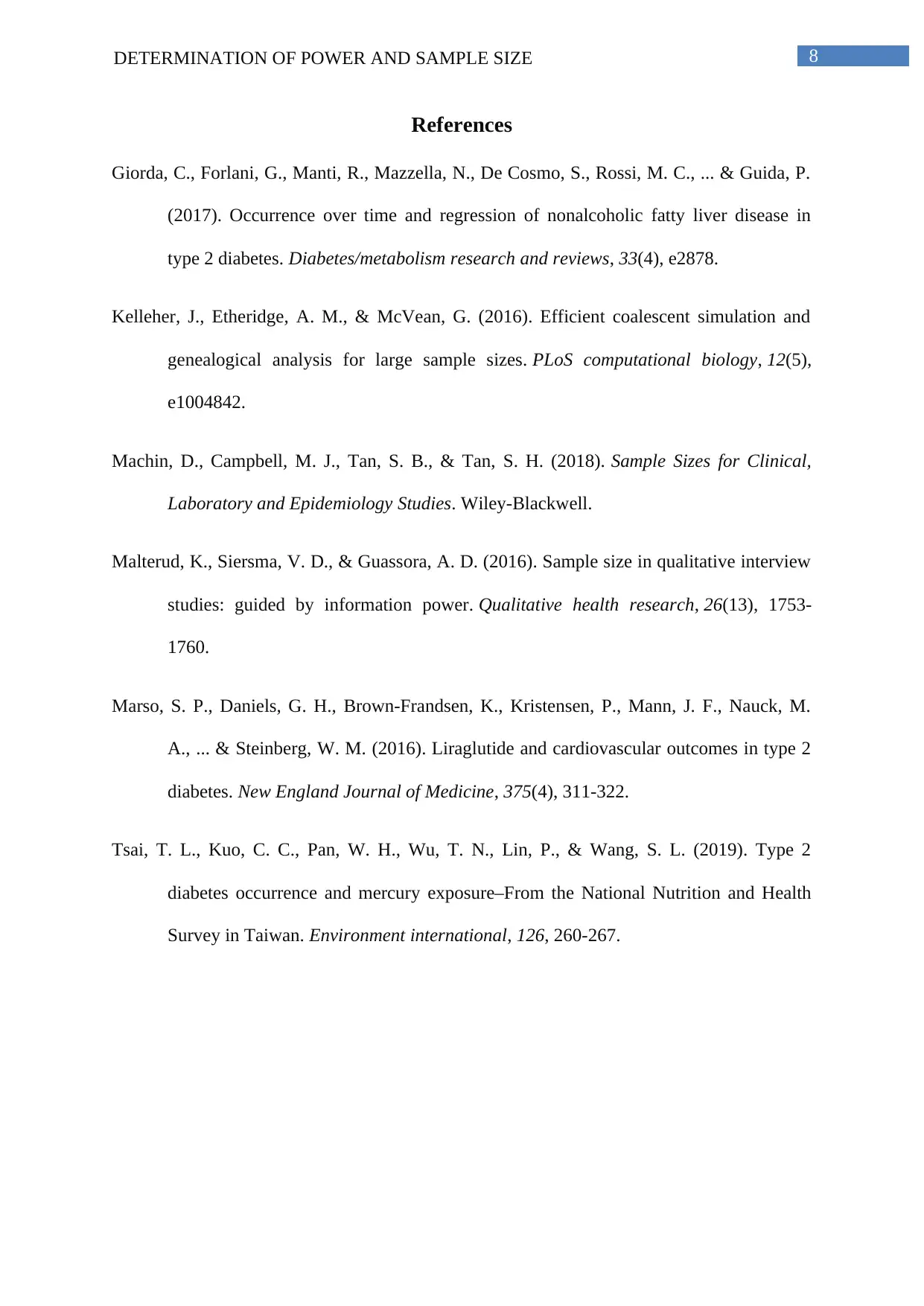
8DETERMINATION OF POWER AND SAMPLE SIZE
References
Giorda, C., Forlani, G., Manti, R., Mazzella, N., De Cosmo, S., Rossi, M. C., ... & Guida, P.
(2017). Occurrence over time and regression of nonalcoholic fatty liver disease in
type 2 diabetes. Diabetes/metabolism research and reviews, 33(4), e2878.
Kelleher, J., Etheridge, A. M., & McVean, G. (2016). Efficient coalescent simulation and
genealogical analysis for large sample sizes. PLoS computational biology, 12(5),
e1004842.
Machin, D., Campbell, M. J., Tan, S. B., & Tan, S. H. (2018). Sample Sizes for Clinical,
Laboratory and Epidemiology Studies. Wiley-Blackwell.
Malterud, K., Siersma, V. D., & Guassora, A. D. (2016). Sample size in qualitative interview
studies: guided by information power. Qualitative health research, 26(13), 1753-
1760.
Marso, S. P., Daniels, G. H., Brown-Frandsen, K., Kristensen, P., Mann, J. F., Nauck, M.
A., ... & Steinberg, W. M. (2016). Liraglutide and cardiovascular outcomes in type 2
diabetes. New England Journal of Medicine, 375(4), 311-322.
Tsai, T. L., Kuo, C. C., Pan, W. H., Wu, T. N., Lin, P., & Wang, S. L. (2019). Type 2
diabetes occurrence and mercury exposure–From the National Nutrition and Health
Survey in Taiwan. Environment international, 126, 260-267.
References
Giorda, C., Forlani, G., Manti, R., Mazzella, N., De Cosmo, S., Rossi, M. C., ... & Guida, P.
(2017). Occurrence over time and regression of nonalcoholic fatty liver disease in
type 2 diabetes. Diabetes/metabolism research and reviews, 33(4), e2878.
Kelleher, J., Etheridge, A. M., & McVean, G. (2016). Efficient coalescent simulation and
genealogical analysis for large sample sizes. PLoS computational biology, 12(5),
e1004842.
Machin, D., Campbell, M. J., Tan, S. B., & Tan, S. H. (2018). Sample Sizes for Clinical,
Laboratory and Epidemiology Studies. Wiley-Blackwell.
Malterud, K., Siersma, V. D., & Guassora, A. D. (2016). Sample size in qualitative interview
studies: guided by information power. Qualitative health research, 26(13), 1753-
1760.
Marso, S. P., Daniels, G. H., Brown-Frandsen, K., Kristensen, P., Mann, J. F., Nauck, M.
A., ... & Steinberg, W. M. (2016). Liraglutide and cardiovascular outcomes in type 2
diabetes. New England Journal of Medicine, 375(4), 311-322.
Tsai, T. L., Kuo, C. C., Pan, W. H., Wu, T. N., Lin, P., & Wang, S. L. (2019). Type 2
diabetes occurrence and mercury exposure–From the National Nutrition and Health
Survey in Taiwan. Environment international, 126, 260-267.
⊘ This is a preview!⊘
Do you want full access?
Subscribe today to unlock all pages.

Trusted by 1+ million students worldwide
1 out of 9
Related Documents
Your All-in-One AI-Powered Toolkit for Academic Success.
+13062052269
info@desklib.com
Available 24*7 on WhatsApp / Email
![[object Object]](/_next/static/media/star-bottom.7253800d.svg)
Unlock your academic potential
Copyright © 2020–2025 A2Z Services. All Rights Reserved. Developed and managed by ZUCOL.




